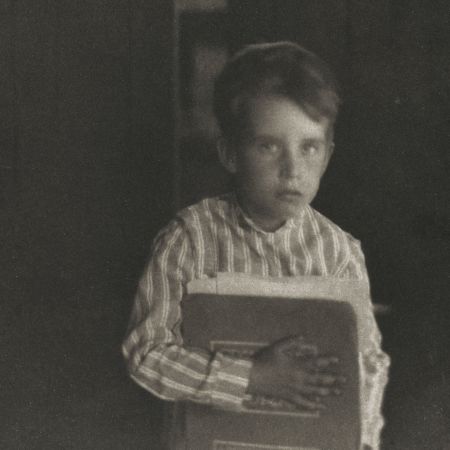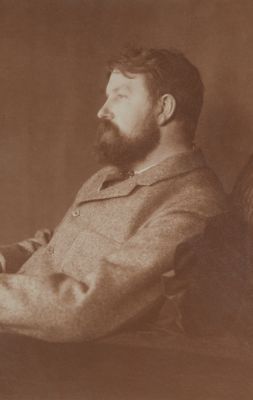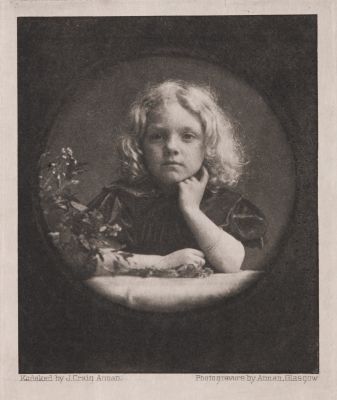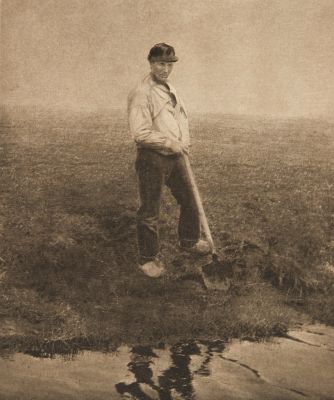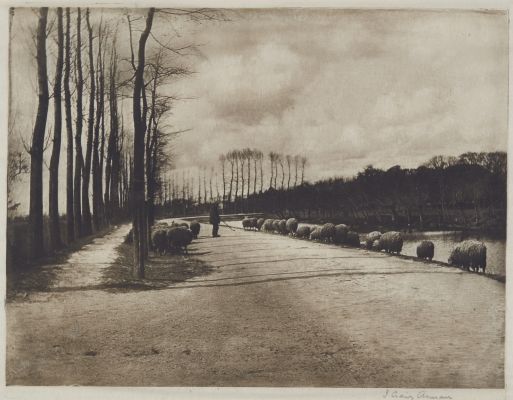
Title
The White FriarsArtist
Annan, James Craig (Scottish, 1864-1946)Key FigureDate
1894Process
PhotogravureAtelier
James Craig AnnanImage Size
11 x 10.9 cm
One of the greatest pictures ever made by means of the camera. Joseph Keliey Camera Notes v. 4 no. 4
This photograph, taken in Italy in 1894 and also known as The White Friars, is an early example of stop-movement photography made by Annan with a hand-held camera, a groundbreaking technological advancement which was the seed of an entire aesthetic movement unique to photography – soon embraced by Stieglitz, and ultimately popularized by Cartier Bresson… this image plants the seed and lays the groundwork for the recognition of photography as a unique fine art.
The print of the two striding monks is, for all its spontaneity, the product of much labor on the plate, fading out the background and softening the forms. The blurring which conveys the idea of motion is not entirely the product of the lens. The photogravure combines his skill in hand-manipulated photomechanical printing with an interest in instantaneous photography as a means to depict genre subjects, two tendencies that were of central concern to Charles Nègre forty years earlier. [1]
In 1894 Annan went on a trip to Italy with fellow photographer D.Y. Cameron. His Italian photographs were shown at the second salon of the Linked Ring, to which he had recently been elected. In reviewing the 1894 Linked Ring exhibition Stieglitz wrote of Annan, Here we deal with a true artist, and a decidedly poetical one at that’ [2]. In 1895 he began to correspond with Stieglitz and he began to be recognized on the international scene. When his work The White Friars was exhibited in New York in 1900, where it was called "Monks Walking" and lent by Stieglitz, it was hailed as one of the greatest pictures ever made by means of the camera .[3] In 1900 Annan exhibited at the Royal Photographic Society, and in the opening speech he shared his views on photography as an art. By accustoming one’s self constantly to see things of beauty, one becomes more sensitive and more able to discriminate rapidly and it is this power of rapid discrimination which is the most useful attribute a photographer can possess.
Reproduced / Exhibited
Buchanan, William. J. Craig Annan: Selected Texts and Bibliography. Oxford: Clio Press, 1994. fig. 10.
Buchanan, William, and J C. Annan. The Art of the Photographer: J. Craig Annan, 1864-1946. Edinburgh: National Galleries of Scotland, 1992. plate 5.
Exposition D’art Photographique, Tro isième Année, 1896: Catalogue. Paris: Photo-Club de Paris, 1896.
Haworth-Booth, Mark. The Golden Age of British Photography, 1839-1900: Photographs from the Victoria and Albert Museum, London [and Others]. New York: Aperture, 1984 p. 174
Margolis, Marianne Fulton. Alfred Stieglitz Camera Work – A Pictorial Guide. New York: Dover Publications, 1978.
Naef, Weston J. The Collection of Alfred Stieglitz: Fifty Pioneers of Modern Photography. New York: Viking Press, 1978. Plate 2, Cat. 17.
Peterson, Christian A. Alfred Stieglitz’s Camera Notes. Minneapolis: Minneapolis Institute of Arts, 1993.
References
[1] Lewis, Jacob W. Charles Negre in Pursuit of the Photographic. , 2012. Print. Lambrechts, Eric, and Luc Salu. Photography and Literature: An International Bibliography of Monographs. London: Mansell, 1992 p. 409
[2] Haworth-Booth, Mark. The Golden Age of British Photography, 1839-1900. Millerton, N.Y: Aperture, 1984.
[3] ibid p. 171
